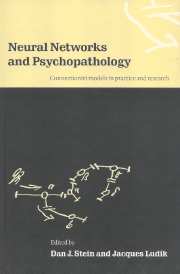The patient in the machine: challenges for neurocomputing
from Epilogue
Published online by Cambridge University Press: 12 January 2010
Summary
This volume has provided many examples of how connectionist models may allow clinicians to replace vague and nonquantitative approaches to psychopathology with a more sophisticated and quantitative paradigm. Nevertheless, several challenges remain for clinicians and researchers interested in consolidating the intersection between connectionism and psychiatry. In this closing contribution, a number of these challenges are discussed.
The challenge of education
The first challenge for neural network modelers is to become included in the mainstream of general psychiatry. It may be argued that neural networks look more mathematical than they are on a practical level. Nevertheless, neural networks may involve more mathematics than many psychiatrists are willing to countenance. At least some preparation is required for comprehension.
However, there is reason to be optimistic that the challenge of education will be met. When the author first presented a grand rounds on neural networks in 1990, he found few psychiatric residents had any computer preparation. Since then, the wave of children who have grown up with computers has reached our residencies, and most are now willing to consider these logicomathematical structures. The author is confident that in the future a working knowledge of neurocomputation will be pushed earlier and earlier in general education, partly because its applications will be everywhere.
We can help by translating neural network models into verbal structures and by beginning to speak during our clinical rounds in the metaphors of neurocomputing. As discussed below, these metaphors are most compatible with a dynamic psychiatry that is cognitively informed. And as their currency grows, computers offer metaphors for many processes of thought.
Information
- Type
- Chapter
- Information
- Neural Networks and PsychopathologyConnectionist Models in Practice and Research, pp. 345 - 362Publisher: Cambridge University PressPrint publication year: 1998
Accessibility standard: Unknown
- 1
- Cited by
